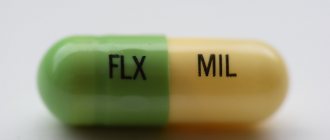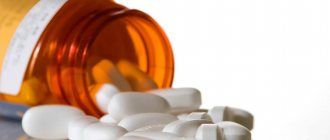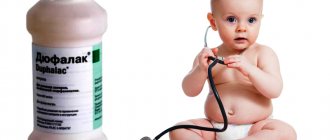Furosemide is classified as a diuretic drug. The medication is prescribed in certain cases, and it is strictly forbidden to use it independently. An overdose of Furosemide leads to serious health problems.
Furosemide is not a new drug that has been used in modern medicine for a long time. But its overdose can be very dangerous to human health. The diuretic blocks the functioning of sorbents of sodium and chlorine ions. This medication also helps remove potassium, magnesium and calcium from the body.
Pharmacokinetics
Furosemide is quickly and completely absorbed by any route of administration. The time to reach maximum concentration in plasma when taken orally is 1-2 hours, when administered intravenously - 0.5 hours.
Bioavailability - 60-70%, relative volume of distribution - about 0.2 l/kg, binding to plasma proteins - 91-97%. Furosemide penetrates the placental barrier and passes into breast milk.
Metabolized in the liver with the formation of mainly glucoronides, the metabolites are inactive. T1/2 - 0.5-1.5 hours with normal renal function. It is excreted predominantly (88%) by the kidneys unchanged and in the form of metabolites, 12% of the administered dose is excreted in bile. It is secreted into the lumen of the renal tubules through the anion transport system existing in the proximal nephron. Clearance - 1.5-3 ml/min/kg.
Symptoms:
- Weakness, lethargy, apathy,
- Painful sensations in the back of the head,
- Respiratory dysfunction, shortness of breath,
- Increased sweating
- Dizziness,
- Nausea, urge to vomit,
- Noise in ears,
- Decreased body temperature
- Development of convulsive manifestations.
With excessive intake of furosemide and acute overdose, a decrease in the amount of circulating blood occurs, which leads to disruption of the blood supply to internal organs. The consequences of this phenomenon can be disturbances in the functioning of the kidneys, heart, and death.
When furosemide is consumed in large quantities, the body becomes dehydrated. The result is disruption of many systems. Blood thickening is often observed when taking furosemide in an increased dosage. Such an overdose causes disruptions in the functioning of the cardiac system and the development of heart attacks.
When is medical help needed?
Medical attention is required in all cases of furosemide intoxication. However, in some cases you need to see a doctor very quickly.
- The child was injured
- Very low pressure
- Lack of consciousness, disturbance of orientation in space,
- Sudden irregularities in heart rhythm,
- Respiratory disorder
- Presence of symptoms of dehydration,
- Sharp blue discoloration of the skin,
- Presence of blood in vomit and feces.
In a medical institution, the patient is given a set of actions to help reduce the toxic effects on the body.
- Administration of medicinal solutions that increase the volume of circulating blood,
- Using a ventilator,
- Prescribing medications to normalize the functionality of the cardiac and respiratory systems,
- Various procedures aimed at eliminating all violations.
Overdose is treated until complete recovery. If necessary, special vitamin complexes are selected. There is no specific antidote for overdose.
Possible consequences
With timely diagnosis and adequate treatment of overdose, complications are rarely a concern. With prolonged or incorrect therapy, the occurrence of the following conditions cannot be ruled out:
- arrhythmia;
- decreased hearing or visual acuity;
- metabolic acidosis or alkalosis;
- allergic reactions in the form of urticaria, dermatitis;
- persistent mental disorders;
- sudden cardiac arrest;
- renal or liver failure.
Combined intoxication with Furosemide and alcohol leads to the death of the victim.
Pharmacodynamics
Furosemide is rapidly absorbed from the stomach and causes a diuretic effect within an hour. The mechanism of action is based on blocking the reabsorption of sodium and chlorine by the renal tubules. Since sodium “pulls” water onto itself, the liquid part of the blood with potassium, magnesium, and calcium dissolved in it is also excreted.
The contractile response of the muscular lining of the veins to the action of vasoconstrictor substances decreases. The expansion of the venous lumen and a decrease in the volume of circulating blood leads to a drop in blood pressure and a decrease in the load on the heart muscle.
When the action of Furosemide ceases, the “rebound phenomenon” is triggered, and the excretion of sodium by the kidneys slows down. When taking the drug once a day, the concentration of the trace element in the blood is leveled out, and blood pressure does not change significantly.
In a medical institution, the patient is given a set of actions to help reduce the toxic effects on the body.
How can you get an overdose?
Furosemide overdose options:
- Errors in prescribing a treatment regimen;
- Self-administration of medication;
- Accidental ingestion of a substance into the body (in elderly people or children);
- Taking the drug as a means of losing weight;
- Overdose resulting from drug intolerance.
We recommend reading: Mushroom treatment and folk remedies for prevention
The simultaneous use of the drug and alcoholic beverages can lead to negative effects on the body .
Purpose of the drug
Furosemide is a pharmacological drug. It has a diuretic effect ─ increases the rate of urine formation and reduces the amount of fluid in the tissues. When taken orally, a strong and rapid effect occurs, but lasts only for a short time. Begins to act within 20 minutes .
The peak effect occurs after 1-2 hours and lasts a maximum of 6 hours. The substance increases the excretion of potassium, calcium, and magnesium salts from the body. The drug also reduces the load on the heart and the tone of the veins, which reduces the volume of circulating blood and reduces blood pressure.
Furosemide is prescribed to patients to combat edema that occurs due to dysfunction of the heart, liver and kidneys, and high blood pressure. It is also used in patients with pulmonary or cerebral edema, and is used for poisoning with chemicals that are excreted unchanged through the kidneys.
Description
The drug enhances the body's elimination of excess fluid, and, accordingly, the amount of urine produced. With it, Furosemide actively removes useful components - magnesium ions, calcium, potassium, phosphate components, bicarbonates, sodium. Therefore, the complications of such an overdose are very dangerous to health.
This medicine is produced in the form of a solution and tablets. The diuretic effect of the drug, regardless of the form of production, is strong, fast and short-term.
After ingestion in tablet form, the effect of the drug appears within half an hour. The maximum concentration is observed after 1.5-2 hours, the effect lasts for 7-8 hours. If the drug is administered intravenously, the effect appears after 6-7 minutes, reaches a maximum after half an hour, duration – 2 hours.
The drug has the ability to penetrate the placenta, so pregnant women should refuse to take it.
Furosemide can only be prescribed to a pregnant woman if the potential benefit to the woman is much greater than the possible risk to her baby. Since the drug is excreted in breast milk, lactation should be stopped while taking Furosemide.
Chronic drug overdose
With systematic use of tablets, thrombophlebitis develops - inflammation of the veins with the formation of blood clots. More common in older people.
The following symptoms are observed from the gastrointestinal tract:
- Nausea, vomiting;
- constipation or diarrhea;
- Pancreatitis ─ inflammation of the pancreas;
- Stagnation of bile.
Symptoms of chronic damage to the nervous system:
- Hearing loss due to damage to the inner ear;
- Fog in the eyes;
- Confusion, nervousness;
- Dizziness, migraines;
- Anorexia.
Allergic manifestations: exfoliative dermatitis, itching, urticaria, photosensitivity (sensitivity to light).
The maximum permissible dose of the drug is 600 mg per day. In medical practice, in some cases, for example, with ascites (fluid accumulation in the abdominal cavity), the dose is increased to 900 mg per day. The lethal dose of Furosemide has not been established , the critical daily dose is 1500 mg.
Diuretics are a common group of medications. They should only be prescribed by doctors. But due to the availability of drugs, people prescribe them to themselves as treatment or for weight loss . One of these drugs is Furosemide, an overdose of which leads to serious disorders in the human body.
Hemoconcentration ─ blood thickening. Blood microcirculation is disrupted, which is manifested by tingling and numbness of the limbs. Serious consequences include thrombosis, which leads to heart attack and stroke, and intracerebral hemorrhage.
Furosemide: overdose and lethal dose – Site about poisoning
Diuretics have a specific effect on the body, promoting the removal of fluid naturally. Most diuretics block the reabsorption of electrolytes in the renal tubules.
This leads to an increase in their secretion, accompanied by the release of a corresponding volume of fluid.
Pharmacodynamic effect
There is a classification of drugs in this group depending on the composition and mechanisms of action:
- Affecting the functions of the epithelial layer of the renal tubules.
- Potassium-sparing.
- Osmotic.
According to the degree of sodium leaching, they are distinguished:
- highly effective diuretics - remove more than 15% Na;
- moderately effective - about 10% Na;
- ineffective - less than 5% Na.
Taking diuretics reduces blood pressure, so you should strictly follow the recommended dosage and medical recommendations.
The hypotensive effect is carried out through two mechanisms:
- Decrease in sodium concentration in the blood.
- Vasodilation, which reduces blood pressure.
For this reason, medications with diuretic properties are actively prescribed for arterial hypertension.
With systematic use, the following occurs:
- relaxation of the smooth muscles of the bile ducts, respiratory tract, arteries, due to which an antispasmodic effect is achieved;
- improving blood microcirculation in the kidneys;
- decreased platelet aggregation;
- eliminating excess load on the ventricles of the heart.
Certain types of diuretics increase fluid pressure in the interstitial space.
Release forms
After analyzing the patient’s physical condition, the course of the disease, and concomitant diagnoses, the doctor prescribes medicine in the form of:
- tablets;
- capsules;
- drops;
- solution for intramuscular or intravenous injection.
Regardless of the form of release, all diuretics have the same purpose - to remove excess moisture from the cavities and tissues of the body by increasing the volume of urine excreted.
Indications for use
Diuretics are prescribed for the following pathological conditions:
- hypertension, especially in elderly patients;
- chronic form of renal, heart failure;
- osteoporosis;
- congenital Liddle syndrome (disorder of sodium-potassium metabolism);
- increased intraocular pressure (glaucoma);
- liver cirrhosis;
- swelling of the heart muscle.
For therapeutic and prophylactic purposes in case of hypertension, thiazide diuretics are taken, which have a mild hypotensive effect with moderately increased blood pressure. Diuretics are used as stroke prevention.
Therapy is conventionally divided into active and supportive. In the first case, a moderate dosage of a potent diuretic is prescribed. In the second, systematic use of diuretics of medium/low effectiveness.
Contraindications
It is prohibited to use diuretics for patients suffering from:
- individual hypersensitivity to sulfonamide derivatives (antibacterial action, as well as agents that lower glucose concentrations);
- K deficiency;
- decompensated form of liver cirrhosis;
- acute respiratory, renal, heart failure;
- diabetes mellitus
Relative contraindications include ventricular arrhythmia.
Possible adverse reactions
The use of thiazide diuretics can cause an increase in the concentration of uric acid in the blood serum, which negatively affects the well-being of patients with gout.
An overdose of diuretics can cause the following adverse reactions:
- drowsiness, loss of strength due to decreased blood pressure;
- thirst, dry mouth;
- headache;
- nausea;
- bowel disorders;
- frequent urination.
In severe cases it is noted:
- arrhythmia;
- muscle hypotonicity;
- spasms, muscle cramps;
- increased blood glucose levels;
- disruption of the menstrual cycle;
- decreased libido, potency.
Ion exchange disturbances often lead to allergic skin reactions. An overdose of osmotic diuretics used for heart failure increases plasma volume, resulting in an increased load on the heart. These phenomena often provoke the development of pulmonary edema.
Pharmacological interaction
The combination of types of diuretics with other pharmaceuticals gives the following effect:
- thiazides, loop diuretics with cardiac glycosides - a decrease in the level of potassium in the blood, which leads to increased toxic properties of nitrogen-free compounds;
- thiazide with NSAIDs - decreased hypotensive, diuretic effect, sodium is retained along with the fluid;
- with sulfinylpyrazone - slowing down the release of urea;
- with sulfonylurea derivatives - decreased effectiveness of antidiabetic agents;
- saluretics with Amiodarone - increases the risk of developing hypokalemia, against the background of which arrhythmia progresses;
- with antibiotics of the aminoglycoside group - the likelihood of nephro-, ototoxic effects;
- with Cephalotin - a similar effect, often observed in elderly patients;
- with depolarizing muscle relaxants - deterioration of neuromuscular conduction;
- potassium-sparing with ACE inhibitors, K drugs - the likelihood of hyperkalemia increases (in case of renal failure);
- with Indomethacin - high risk of developing renal failure, decreased diuretic effect.
To avoid overdose, simultaneous use of different forms of diuretics is not recommended.
Methods of application
The most common saluretic Furosemide is used:
- orally;
- intravenously;
- intramuscularly.
In the first case - 40 mg in the morning. If necessary, 80–160 mg in several doses, maintaining an interval of at least 6 hours. As the severity of symptoms decreases, the dose is reduced gradually, increasing the intervals between doses to 1–2 days.
Scheme of use for hypertension: 20-40 mg (maximum 80 mg) once intramuscularly, intravenously - 20-60 (maximum 120 mg) mg 1-2 times a day for a week or more.
For patients with severe renal failure - 240 - 320 mg per day; when swelling decreases, the amount of the administered drug is reduced, increasing the intervals between doses.
Symptoms and causes of overdose
There are several reasons for exceeding recommended doses of diuretic medications:
- forgetfulness of patients, especially the elderly;
- deliberate use for the purpose of quickly losing weight or removing doping from the body of athletes;
- accidental intake by children.
Characteristic symptoms:
- a sharp decrease in blood pressure;
- dizziness;
- presyncope, fainting;
- impairment of visual and auditory function;
- feeling of thirst, dry mouth, indicating dehydration.
An overdose of chronic diuretics occurs when the dose is incorrectly selected. As a result, pathological changes in internal organs occur, in which the following is observed:
- constant fatigue;
- dry skin, mucous membranes;
- drowsiness;
- decreased performance and concentration.
In some cases, anorexia, paresthesia, convulsions, and dyspeptic disorders develop.
First aid
For a victim of an overdose, you should immediately call an ambulance. In the meantime, take measures to neutralize the toxic effects.
After oral administration of diuretics that cause poisoning, it is necessary to perform gastric lavage. To do this you need to prepare a solution:
- 1 liter of clean warm water;
- 1 tbsp. l. salt.
Drink in one gulp, induce vomiting by pressing your index finger on the base of the tongue.
Next, replenish fluid loss by drinking plenty of fluids, which will prevent dehydration. Sweet, strong black tea will help normalize blood pressure.
Other methods of drug administration are used, as a rule, in hospital settings, where in case of an overdose they provide qualified medical care.
Treatment of diuretic poisoning
Antitoxic therapy is carried out only in medical institutions. To replenish the volume of circulating blood, droppers with solutions are used:
Potassium and magnesium containing solutions normalize the activity of the cardiovascular system. Low blood pressure is increased with hypertensive medications.
Overdose of diuretics is common among hypertensive patients, especially the elderly.
A similar phenomenon is often observed among athletes and those who try to lose weight and remove excess fluid from the body in a short time.
When the first symptoms of poisoning appear, you should immediately consult a doctor. Next, you need to take measures to reduce intoxication and prevent serious consequences.
Source:
Furosemide overdose
An overdose of diuretics, a group of which includes furosemide, can result in serious health problems. Diuretics are prescribed in strictly defined cases, and their independent use is strictly prohibited, especially for people with a history of certain concomitant diseases.
Under what circumstances does an overdose occur?
Furosemide for the treatment of somatic diseases is prescribed by doctors strictly according to indications. In the event that the patient is treated in a hospital, responsibility for administering or giving the medicine rests with the staff and usually an overdose in a hospital is not possible.
For treatment at home, the patient is prescribed a strictly selected dose. During therapy, continuous assessment of biochemical blood parameters is indicated to exclude disturbances in water and electrolyte balance. When treating with diuretics, the doctor may also prescribe the use of potassium supplements, which reduces the likelihood of side effects.
A diet rich in foods containing potassium is also recommended. That is, if Furosemide therapy is selected correctly and the patient is fully informed about the consequences of taking a larger dose, an overdose is not possible.
Source: https://bdc03.ru/prochee/furosemid-peredozirovka-i-smertelnaya-doza.html
Patient reviews about the use of the drug
Reviews from people who were treated with the drug at one time or another in their lives vary.
Some people do not tolerate it well: constant surges in blood pressure and dizziness forced such patients to change the drug to another. In general, diuretic drugs are rarely well tolerated: to varying degrees, patients experience discomfort associated with dehydration. Hence the many negative reviews.
Patients who are in good health and who do not have chronic diseases most often tolerate Furosemide well. Reviews confirm that swelling subsides after taking one tablet.
Symptoms of overdose
Symptoms of an overdose of Furosemide:
- sudden darkening of the eyes;
- fainting state;
- perspiration and fever;
- dizziness;
- severe nausea;
- gagging;
- sharp pain in the epigastric region.
If these symptoms appear after taking the pill, you must call an ambulance. If such an opportunity is absent, then the patient has a natural question: “What to do?”
An overdose of Furosemide can cause kidney and heart failure, so you should try to get rid of any remaining drug in the stomach. To do this, you should provoke vomiting by irritating the root of your tongue with your fingers.
Why does overdose occur?
A drug for the treatment of somatic diseases is prescribed by a doctor if there are certain indications. If the patient’s therapy is carried out in a hospital setting, then responsibility for the use of the medicine rests with the doctors. In general, an overdose within the walls of a hospital is not possible.
For therapy at home, the patient is recommended to take a strictly prescribed dose.
During treatment with Furosemide, it is necessary to constantly monitor biochemical blood parameters to exclude an imbalance of water and electrolytes. For diuretic therapy, your doctor may recommend taking potassium supplements to reduce the risk of side effects.
The use of a large number of tablets is possible for several reasons.
- Elderly patients have poor memory. Due to their forgetfulness, they can use Furosemide several times a day. Therefore, it is recommended to discuss all the nuances of prescribing a diuretic in old age with the patient’s relatives.
- Also, the drug can be intentionally used in excessive quantities.
There is an opinion that taking several Furosmid tablets at the same time helps to lose a few extra pounds. And this is true, however, you need to realize that the consequences of such weight loss can be very dangerous to your health.
Furosemide is sometimes used for non-medicinal purposes by athletes. The drug helps remove doping from the blood and promotes weight loss, which in some cases is necessary for an athlete to fall into a certain weight category.
Poisoning with this drug is also due to the individual characteristics of the body. Some patients may experience an increased reaction to the components of the product.
conclusions
Furosemide is a very effective drug that has a diuretic effect (diuretic). Some people use this product to reduce weight.
In fact, the drug has such a property, and it will be possible to achieve the desired loss of several kg when taking it, but the health consequences are very dangerous. In some cases, an overdose may result in death. Furosemide should be used only as prescribed by a doctor, without deviating from the prescribed dosage. To prevent a child from being poisoned by the drug, Furosemide should be stored in a place where children cannot find it.
First aid
In case of poisoning due to parenteral administration of the drug, you should immediately stop using the drug, put the victim in a horizontal position, and raise your legs slightly. It is important to ensure access to fresh air - all windows must be opened, clothes that restrict movement must be unbuttoned.
If you notice symptoms of poisoning with this drug, you need to provide first aid to the victim.
- Cleanse the stomach - drink 1-1.5 liters of water at room temperature and induce vomiting by pressing it onto the back of the tongue with your fingers. Instead of water, you can use a weak solution of potassium permanganate.
- Give the patient a saline laxative.
- Use any enterosorbent that will help remove the remaining toxic substances from the body. Before using the sorbent, be sure to read the dosing instructions.
Indications for use
Indications for use of the tablet form:
- The patient has nephrotic syndrome;
- Swelling of various origins, including due to liver diseases, due to the presence of renal and heart failure;
- Complex form of arterial hypertension.
The drug is prescribed in the form of a solution:
- When performing forced diuresis;
- To eliminate hypercalcemia, hypertensive crisis;
- If the patient has eclampsia;
- With hepatic cirrhosis;
- In case of acute failure of the heart muscle;
- In the presence of swelling due to decompensated heart failure;
- With cerebral edema of any severity;
- In severe arterial hypertension;
Furosemide is a powerful drug that has a diuretic effect. The drug is mainly used as an emergency medicine; sigmatic use is permissible only in the presence of pronounced congestive processes in the blood circulation.
In some cases, an overdose of this drug is possible. How does it manifest itself? How to provide first aid to a person who has been overdosed? Why is such a drug overdose dangerous? All this will be discussed in our article.
The use of a large number of tablets is possible for several reasons.
When is Furosemide prescribed?
The drug has a pronounced diuretic effect. The diuretic effect lasts up to 6 hours. Furosemide is produced in the form of an injection solution and tablets.
A diuretic is prescribed for pathologies that are accompanied by fluid retention in the body. Indications for use:
- heart and kidney failure;
- chronic kidney and liver diseases in the acute stage;
- hypertension.
Furosemide is prescribed for intoxication with certain chemicals and cerebral edema. The drug helps improve the patient’s well-being during a hypertensive crisis.
Possible consequences
The consequences of an overdose of Furosemide can be:
- acute renal failure;
- atrioventricular block;
- thromboembolism;
- collapse, shock;
- coma, death.
Video from YouTube on the topic of the article:
Education: higher education, 2004 (State Educational Institution of Higher Professional Education “Kursk State Medical University”), specialty “General Medicine”, qualification “Doctor”. 2008-2012 – postgraduate student of the Department of Clinical Pharmacology, KSMU, Candidate of Medical Sciences (2013, specialty “pharmacology, clinical pharmacology”). 2014-2015 – professional retraining, specialty “Management in Education”, Federal State Budgetary Educational Institution of Higher Professional Education “KSU”.
The information is generalized and is provided for informational purposes. At the first signs of illness, consult a doctor. Self-medication is dangerous to health!
Signs of drug poisoning
Symptoms of exceeding the dose of Furosemide are associated with the effect of the drug. After the introduction of the active substance, the body begins to lose minerals important for normal life - potassium, magnesium, sodium - with water. This provokes a deterioration in the general condition.
The first symptoms of overdose appear when taking more than 1.5 grams of Furosemide per day. If you are hypersensitive to the active substance, poisoning can occur even when using a smaller amount of the product.
Signs of diuretic overdose:
- cramps in the muscles of the arms and legs;
- a sharp decrease in blood pressure;
- attacks of dizziness, fainting;
- heart rhythm disturbance, tachycardia;
- deterioration of visual acuity, hearing loss;
- constant thirst;
- decreased skin elasticity, peeling.
With prolonged intoxication, a person experiences constant weakness and drowsiness, and quickly gets tired of any work. The functioning of the digestive tract is disrupted - attacks of nausea, flatulence, and loss of appetite are tormented. Cramps become more frequent, arms, legs, and other parts of the body go numb. Shock and collapse are possible.
A biochemical blood test shows a decrease in the level of electrolytes - potassium, magnesium, sodium, calcium. The blood becomes thicker, and the risk of vascular thrombosis increases.
Diagnostics
It is based on the collection of anamnesis of life, illness and information obtained during a general examination. To determine the severity of an overdose, the doctor pays special attention to heartbeat, breathing, diuresis and consciousness. Next, the person undergoes laboratory and instrumental examination, the most important are:
- detailed general, biochemical blood test;
- general urine test, if available;
- electrocardiogram.
Ultrasound of the abdominal organs, X-rays, MRI and CT are required only if the patient suffers from other pathologies that worsen the course of poisoning, or complications have developed. Consultation with a psychiatrist or therapist is required.
First aid and treatment
An overdose of Furosemide requires seeking medical help. The first actions in case of poisoning depend on the method of application of the drug. If a person takes several tablets at once, it is necessary to rinse the stomach (before the doctors arrive). To do this, give 1.5–2 liters of warm boiled water to drink, press on the root of the tongue, provoking vomiting. The procedure is repeated 2-3 times.
Medical care in a hospital consists of saturating the body with fluid and electrolytes. To restore blood volume, Disol and Trisol solutions, magnesium and potassium-containing drugs are administered intravenously.
Symptomatic therapy is carried out. When blood pressure decreases, caffeine-based medications are administered. At home, you can take a Citramon tablet, Eleutherococcus extract, or drink strong coffee or tea. If necessary, medications are administered to normalize the heart rhythm.
Attention! Long-term abuse of Furosemide requires dosage adjustment or change of diuretic. The drug is not discontinued immediately. Doctors gradually reduce the amount of medication - this avoids excessive stress on the kidneys.
What does the diuretic composition combine with and what does it not interact with?
Before you start taking pills, you need to find out if you have any of the components included in the medication. You can ask your doctor for a list of ingredients. It is also very important to tell your doctor if you plan to take vitamins, supplements, or other medications at the same time.
Do not forget to notify your doctor about taking medications. This is very important, since Furosemide does not interact with some drugs.
This list includes:
- Gentamicin, Tobramycin;
- Benazepril, Captopril, Fosinopril, Quinapril and all drugs ending in – adj;
- Candesartan, Irbesartan and all drugs ending with - rotan;
- Phenobarbital, Secobarbital;
- Betamethasone, Cortisone, Hydrocortisone and all drugs ending in -zone;
- Cyclosporine, Cisplatin.
Your testimony will help the doctor prescribe the correct treatment regimen and carefully monitor side effects. If you miss a dose, you do not need to take a double dose next time. Just continue to follow all instructions.
Furosemide is considered the most powerful diuretic. It is mainly prescribed in case of emergency. After oral administration, the effect occurs within half an hour and lasts about 6 hours. In case of severe intoxication, as already mentioned, it is necessary to rinse the stomach. How to do this correctly?
- First you need to drink a liter or one and a half warm water. But for a better effect, it is worth diluting it with manganese. The main thing is not to overdo it, otherwise you won’t be able to drink the solution. The water should turn out slightly pinkish. Then use the back of a small spoon to press down on the root of your tongue. These manipulations will help provoke vomiting. If you make the solution too dark, vomiting may occur without outside intervention. But this is bad, since we need to disinfect the stomach. This will not happen unless the solution gets inside.
- After which a saline laxative is taken. Magnesium sulfate is most often used.
- Next you should take enterosorbent. Activated carbon is very popular here. The dosage is calculated as follows: 1 tablet per 10 kg of the victim’s body weight.
If severe intoxication with a diuretic drug occurs, call an ambulance. They will take the victim to the hospital, where they will perform certain manipulations:
- replenish the volume of incoming blood (Ringer, sodium chloride solution, Poliglyukin are suitable for these purposes);
- perform artificial ventilation;
- special solutions are administered intravenously;
- Prescribe medications for proper heart function.
Helpful information:
Remember that medications and alcoholic drinks should not be mixed. Every year in our country up to 900 thousand people die from the effects of alcohol. Moreover, many died due to the simultaneous use of medications and alcoholic beverages.
Furosemide has several analogues, but their effects are inferior to the diuretic. The doctor prescribes a treatment regimen with tablets depending on the patient’s age, weight and individual characteristics. Abuse of the drug is extremely dangerous, as it has side effects.
An overdose of diuretics, a group of which includes furosemide, can result in serious health problems. Diuretics are prescribed in strictly defined cases, and their independent use is strictly prohibited, especially for people with a history of certain concomitant diseases.










